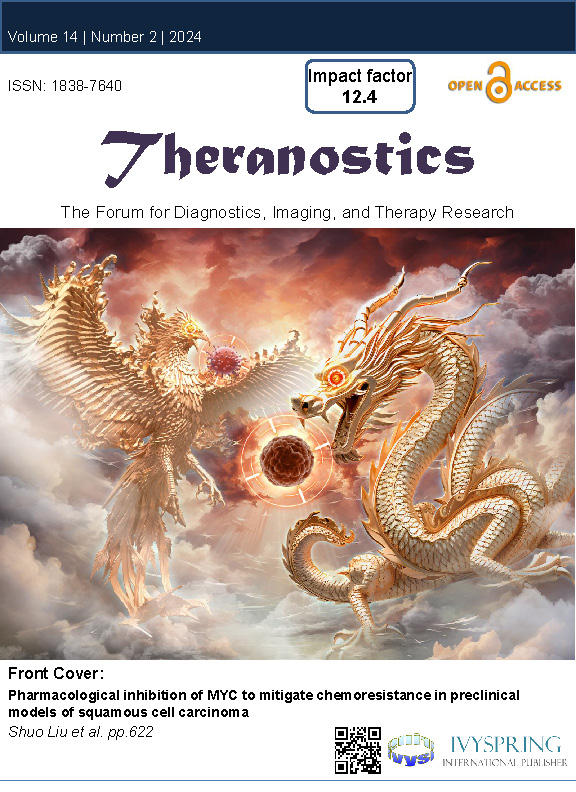通过削弱 P-gp 的功能,双截 GlcNAc 修饰可逆转化疗耐药性
IF 12.4
1区 医学
Q1 MEDICINE, RESEARCH & EXPERIMENTAL
引用次数: 0
摘要
理由化疗耐药性是导致抗乳腺癌化疗失败的一个关键因素。尽管糖基化异常与乳腺癌的进展密切相关,但人们对糖共轭物在化疗耐药性中的功能仍知之甚少:在体外和体内测定了化疗耐药乳腺癌细胞中双截N-乙酰葡糖胺(GlcNAc)的水平和调节作用。在糖蛋白组学的指导下,鉴定了P-糖蛋白(P-gp)上的特异性双连接GlcNAc位点。共免疫沉淀耦合质谱(Co-IP-MS)和邻近标记质谱鉴定了 P-gp 的相互作用组,并通过位点/截断突变和结构模拟研究了位点特异性双链GlcNAc的生物学功能:化疗耐受性乳腺癌细胞中双截面 GlcNAc 水平降低,同时 P-gp 表达增强。增强的双链GlcNAc能有效逆转化疗耐药性。机械研究发现,双截GlcNAc会损害Ezrin与P-gp之间的结合,导致膜P-gp的表达减少。将 GlcNAc 一分为二可抑制 VPS4A 介导的 P-gp 募集到微囊中,并抑制化疗耐药性的传递。结构动力学分析表明,在Asn494处将GlcNAc一分为二会引入结构限制,从而使构象僵化并抑制P-gp的活性:我们的研究结果突显了GlcNAc双截在化疗耐药性中的关键作用,并提出了在乳腺癌治疗中通过调节特定糖基化逆转化疗耐药性的可能性。本文章由计算机程序翻译,如有差异,请以英文原文为准。
Bisecting GlcNAc modification reverses the chemoresistance via attenuating the function of P-gp
Rationale: Chemoresistance is a key factor contributing to the failure of anti-breast cancer chemotherapy. Although abnormal glycosylation is closely correlated with breast cancer progression, the function of glycoconjugates in chemoresistance remains poorly understood./nMethods: Levels and regulatory roles of bisecting N-acetylglucosamine (GlcNAc) in chemoresistant breast cancer cells were determined in vitro and in vivo. Glycoproteomics guided identification of site-specific bisecting GlcNAc on P-glycoprotein (P-gp). Co-immunoprecipitation coupled mass spectrometry (Co-IP-MS) and proximity labelling MS identified the interactome of P-gp, and the biological function of site-specific bisecting GlcNAc was investigated by site/truncation mutation and structural simulations./nResults: Bisecting GlcNAc levels were reduced in chemoresistant breast cancer cells, accompanied by an enhanced expression of P-gp. Enhanced bisecting GlcNAc effectively reversed chemoresistance. Mechanical study revealed that bisecting GlcNAc impaired the association between Ezrin and P-gp, leading to a decreased expression of membrane P-gp. Bisecting GlcNAc suppressed VPS4A-mediated P-gp recruitment into microvesicles, and chemoresistance transmission. Structural dynamics analysis suggested that bisecting GlcNAc at Asn494 introduced structural constraints that rigidified the conformation and suppressed the activity of P-gp./nConclusion: Our findings highlight the crucial role of bisecting GlcNAc in chemoresistance and suggest the possibility of reversing chemoresistance by modulating the specific glycosylation in breast cancer therapy.
求助全文
通过发布文献求助,成功后即可免费获取论文全文。
去求助
来源期刊

Theranostics
MEDICINE, RESEARCH & EXPERIMENTAL-
CiteScore
25.40
自引率
1.60%
发文量
433
审稿时长
1 months
期刊介绍:
Theranostics serves as a pivotal platform for the exchange of clinical and scientific insights within the diagnostic and therapeutic molecular and nanomedicine community, along with allied professions engaged in integrating molecular imaging and therapy. As a multidisciplinary journal, Theranostics showcases innovative research articles spanning fields such as in vitro diagnostics and prognostics, in vivo molecular imaging, molecular therapeutics, image-guided therapy, biosensor technology, nanobiosensors, bioelectronics, system biology, translational medicine, point-of-care applications, and personalized medicine. Encouraging a broad spectrum of biomedical research with potential theranostic applications, the journal rigorously peer-reviews primary research, alongside publishing reviews, news, and commentary that aim to bridge the gap between the laboratory, clinic, and biotechnology industries.
 求助内容:
求助内容: 应助结果提醒方式:
应助结果提醒方式:


